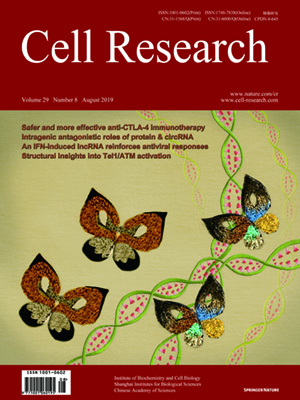
Volume 29, No 8, Aug 2019
ISSN: 1001-0602
EISSN: 1748-7838 2018
impact factor 17.848*
(Clarivate Analytics, 2019)
Volume 29 Issue 8, August 2019: 641-654
ORIGINAL ARTICLES
Interferon-inducible cytoplasmic lncLrrc55-AS promotes antiviral innate responses by strengthening IRF3 phosphorylation
Yumei Zhou1, Mengxuan Li2, Yiquan Xue2, Zhiqing Li2, Weitao Wen1, Xingguang Liu2, Yuanwu Ma3, Lianfeng Zhang3, Zhongyang Shen4 and Xuetao Cao 1,2,5,6
1 Institute of Immunology, Zhejiang University School of Medicine, Hangzhou 310058 Zhejiang, China; 2National Key Laboratory of Medical Immunology & Institute of Immunology, Second Military Medical University, 200433 Shanghai, China; 3Key Laboratory of Human Disease Comparative Medicine, National Health Commission of China, Institute of Laboratory Animal Science, Peking Union Medicine College, Chinese Academy of Medical Sciences, 100021 Beijing, China; 4Department of Liver Transplantation, Tianjin First Center Hospital, Nankai University, 300070 Tianjin, China; 5Department of Immunology & Center for Immunotherapy, Institute of Basic Medical Sciences, Peking Union Medical College, Chinese Academy of Medical Sciences, 100005 Beijing, China and 6College of Life Science, Nankai University, 300071 Tianjin, China
Correspondence: Xuetao Cao (caoxt@immunol.org)
Type I interferon (IFN-I) production is efficiently induced to ensure a potent innate immune response to viral infection. How this response can be enhanced, however, remains to be explored. Here, we identify a new cytoplasmic long non-coding RNA (lncRNA), lncLrrc55-AS, that drives a positive feedback loop to promote interferon regulatory factor 3 (IRF3) signaling and IFN-I production. We show that lncLrrc55-AS is virus-induced in multiple cell types via the IFN-JAK-STAT pathway. LncLrrc55-AS-deficient mice display a weakened antiviral immune response and are more susceptible to viral challenge. Mechanistically, lncLrrc55-AS binds phosphatase methylesterase 1 (PME-1), and promotes the interaction between PME-1 and the phosphatase PP2A, an inhibitor of IRF3 signaling. LncLrrc55-AS supports PME-1-mediated demethylation and inactivation of PP2A, thereby enhancing IRF3 phosphorylation and signaling. Loss of PME-1 phenocopies lncLrrc55-AS deficiency, leading to diminished IRF3 phosphorylation and IFN-I production. We have identified an IFN-induced lncRNA as a positive regulator of IFN-I production, adding mechanistic insight into lncRNA-mediated regulation of signaling in innate immunity and inflammation.
https://doi.org/10.1038/s41422-019-0193-0
FULL TEXT | PDF
Browse 1175


